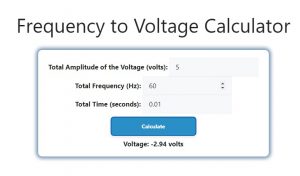About Frequency to Voltage Calculator (Formula)
A Frequency to Voltage Calculator is a useful tool in electronics and engineering, helping convert a given frequency into its corresponding voltage. This is commonly used in signal processing, audio applications, and various electrical devices. Understanding the relationship between frequency and voltage allows for accurate control and analysis of electrical systems.
Formula
The formula for converting frequency to voltage is:
Voltage (V) = Amplitude (Va) * sin(2 * pi * Frequency (f) * Time (t))
This equation shows how voltage varies with respect to frequency and time in a sinusoidal waveform.
How to Use
- Determine the amplitude (Va): This is the maximum voltage of your system or signal.
- Identify the frequency (f): This is the frequency in hertz (Hz) of the waveform you are analyzing.
- Input the time (t): Time is measured in seconds and is used to calculate the instantaneous voltage at any given point.
- Apply the formula: Multiply the amplitude (Va) by the sine of 2 * pi * frequency * time to find the corresponding voltage at that specific time.
Example
Let’s say you have a waveform with an amplitude (Va) of 5V, a frequency (f) of 60Hz, and you want to calculate the voltage at t = 0.01 seconds:
V = 5 * sin(2 * pi * 60 * 0.01)
V = 5 * sin(3.7699)
V ≈ 5 * (-0.5878)
V ≈ -2.94V
At t = 0.01 seconds, the voltage is approximately -2.94 volts.

FAQs
- What is a Frequency to Voltage Converter?
It’s a device or circuit that converts an input frequency into a proportional voltage output. - How does frequency affect voltage?
In a sinusoidal waveform, voltage varies periodically based on the input frequency, with higher frequencies resulting in faster oscillations of voltage. - Where is a Frequency to Voltage Calculator used?
It is used in applications such as signal processing, audio equipment, radio communications, and various control systems. - Can I use this calculator for both AC and DC signals?
This formula specifically applies to AC signals, where voltage and frequency are variable. - What is the significance of the sine function in the formula?
The sine function represents the oscillating nature of AC voltage, where the signal varies between positive and negative values in a cyclic manner. - What does the amplitude (Va) represent?
Amplitude is the peak voltage of the waveform, or the maximum value that the voltage reaches during each cycle. - Why do we use 2 * pi in the formula?
The term 2 * pi is used to convert the frequency into a full cycle of a sine wave, as one full cycle is 2π radians in angular frequency. - How can I measure the frequency of a signal?
You can measure the frequency using a frequency counter, oscilloscope, or function generator. - What happens if the frequency increases?
As the frequency increases, the waveform cycles faster, meaning the voltage oscillates more rapidly within the same time period. - What is the unit of frequency in this calculation?
Frequency is measured in hertz (Hz), which represents the number of cycles per second. - Is the time (t) in seconds?
Yes, time (t) is measured in seconds for the purposes of this calculation. - Can this formula be used for non-sinusoidal waves?
No, this formula is specifically designed for sinusoidal waveforms, where voltage follows a sine wave pattern. - Does the formula account for phase shifts?
This basic formula does not include phase shift, which can be added with an additional phase angle term if necessary. - What’s the role of pi in the formula?
Pi (π) represents the mathematical constant used to calculate angular frequency, as part of the periodic nature of sine waves. - What types of devices use frequency to voltage conversion?
Devices like speed sensors, tachometers, and certain audio equipment rely on frequency to voltage conversion. - Can the frequency to voltage conversion be linear?
In certain cases, a linear relationship between frequency and voltage can be achieved using specific circuit designs, but the basic sinusoidal relationship is non-linear. - Can I use this calculator for high frequencies?
Yes, the calculator can handle high frequencies as long as you input the correct values, but extremely high frequencies might require specialized equipment for accurate measurement. - What are the limitations of this formula?
The formula assumes ideal conditions with a perfect sinusoidal waveform, and real-world applications may have noise or distortion affecting the results. - What happens to voltage at zero frequency?
At zero frequency (DC), the sine function becomes a flat line, resulting in a constant voltage equal to the amplitude (Va). - How does time (t) affect the output voltage?
Time determines the specific point in the waveform cycle, affecting whether the voltage is positive, negative, or zero at that moment.
Conclusion
The Frequency to Voltage Calculator is a powerful tool for understanding the relationship between frequency and voltage in sinusoidal waveforms. Whether for signal processing or electronic design, using this calculator helps you accurately convert frequency into voltage for a variety of practical applications.